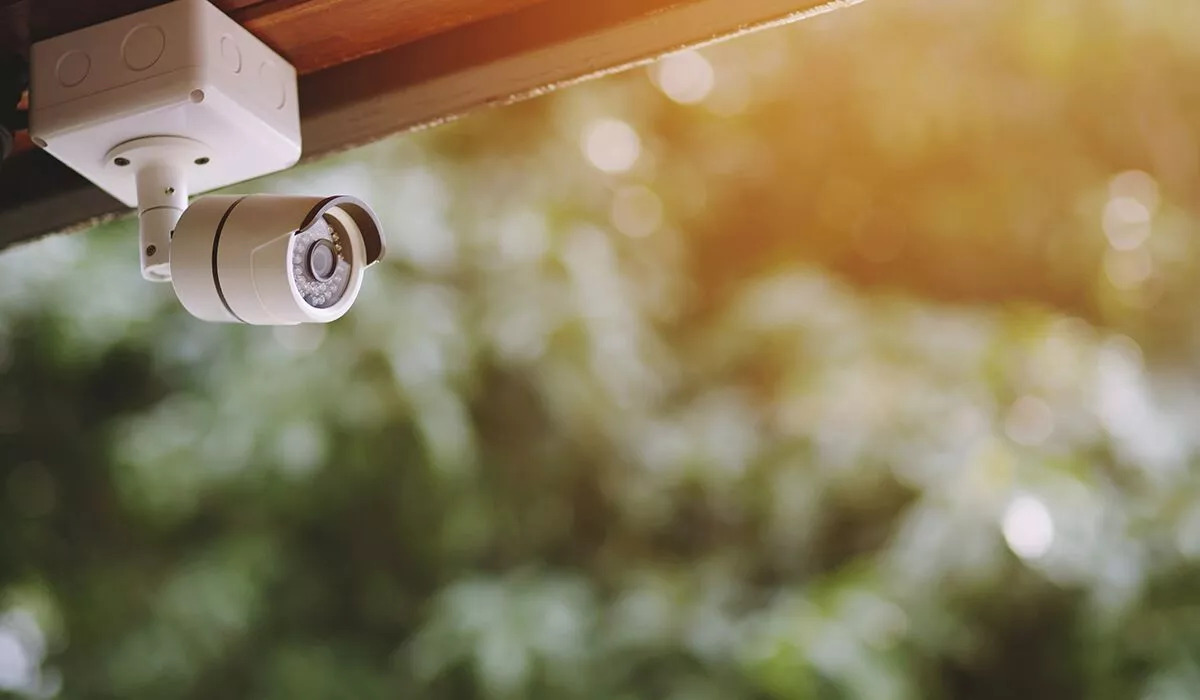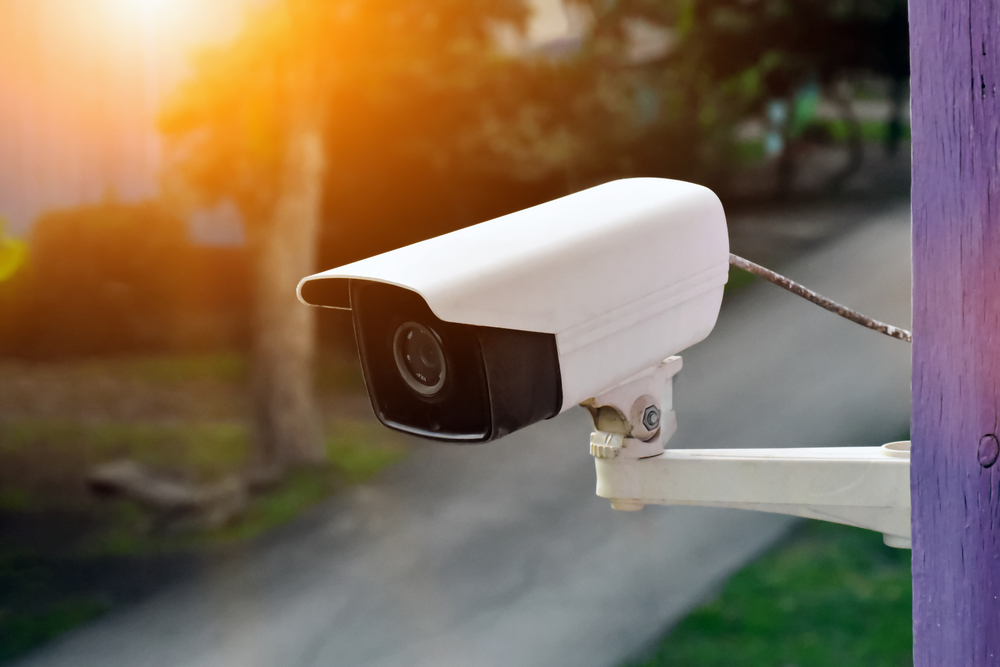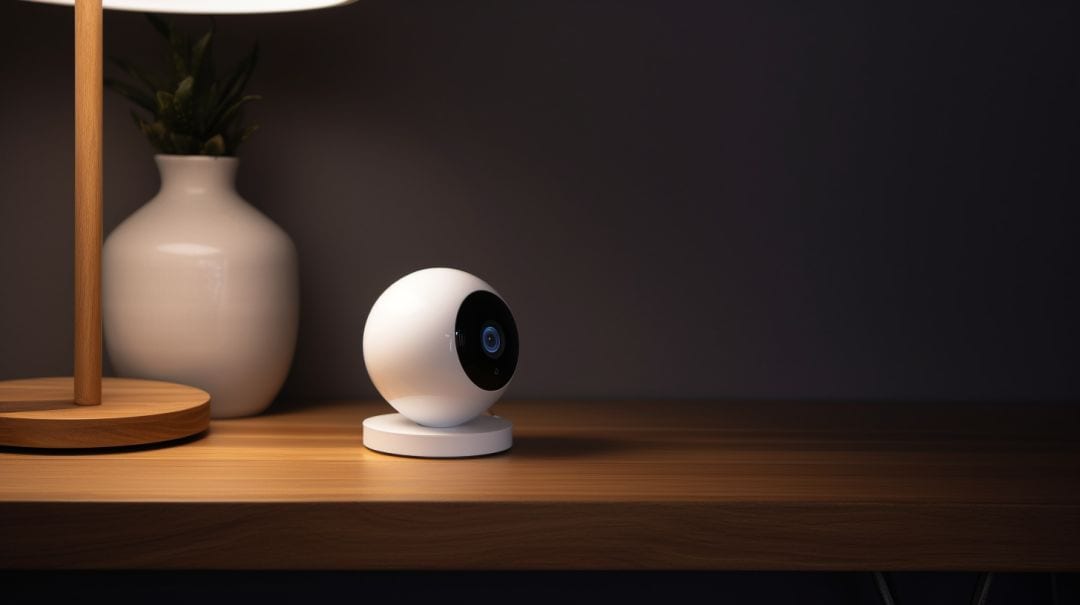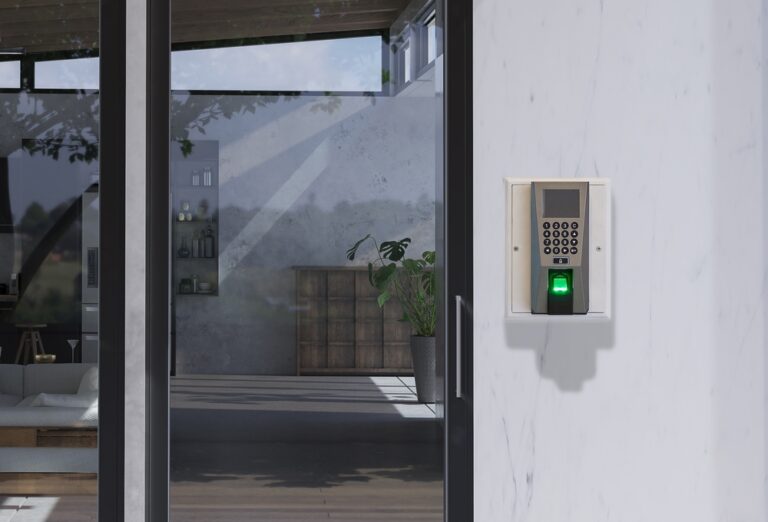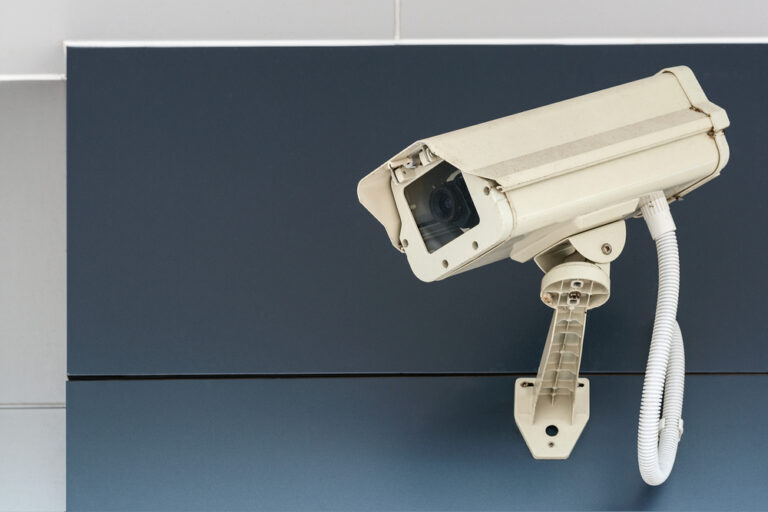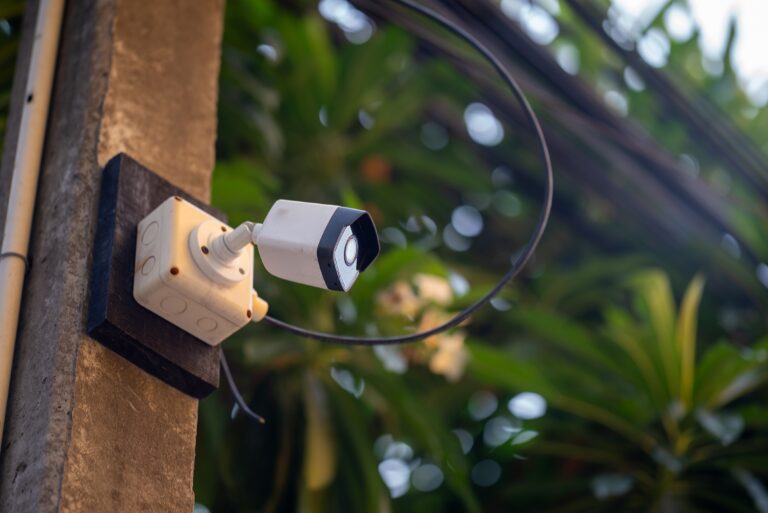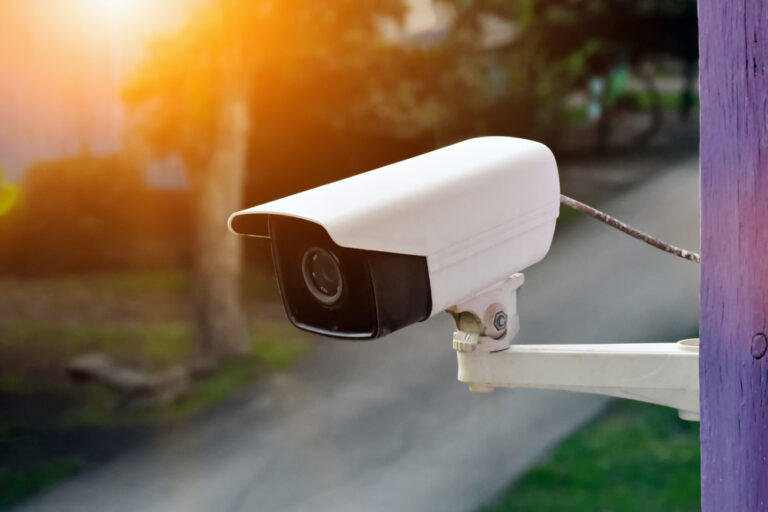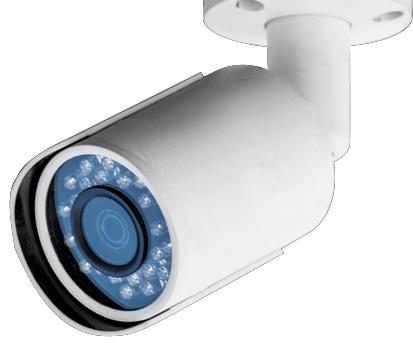- 1) Key Takeaways
- 2) Understanding Home Security
- 3) Securing the Exterior of Your Home
- 4) Taking an Active Role in Your Home’s Security
- 5) Adding Additional Security Measures
- 6) Preventing House Fires
- 7) Home Security Tips and Facts
- 8) Company Research
- 9) Home Security Resources
- 10) Conclusion
-
11)
FAQs
- 11.1) How can I make my doors and windows more secure against intruders?
- 11.2) What lighting tactics effectively deter burglars?
- 11.3) How do I secure my garage against break-ins?
- 11.4) How can I prevent package theft from my porch?
- 11.5) What high-tech security measures can boost my home’s protection?
In the world of home security, there’s a common belief that burglaries are random, spur-of-the-moment crimes. However, the reality is far different. As a seasoned expert in home security with years of experience analyzing crime patterns and prevention strategies, I can assure you that intruders often meticulously plan their moves.
They scout for weaknesses in your home’s defenses, making it crucial to stay one step ahead. With millions of households embracing alarm systems and smart technology to safeguard their homes, understanding the ins and outs of modern security has never been more important.
Securing your sanctuary is about mixing old-school wisdom with new-age tech. 76% of Americans today take steps to protect their abodes, yet many still overlook simple habits and gadgets that could shield them even further from harm’s way.
This article will serve as your blueprint for fortifying your living space against unwanted guests—both physical and digital—with easy-to-implement tips validated by professionals and stats you can trust.
Get ready to unlock peace of mind!
Key Takeaways
- Install strong deadbolt locks on all exterior doors and reinforce them with strike plates. Use window stops to prevent windows from opening too wide, and consider smart locks and alarm systems for greater security.
- Motion sensor lights around your home can deter burglars. Illuminate entry points like the front door and landscape areas to reduce hiding spots, using energy-efficient LED or solar-powered lights where possible.
- Secure garages by having a good locking mechanism in place, store tools that could be used for breaking in securely, and consider smart garage door openers that send you alerts.
- Make sure Wi-Fi networks are protected with strong passwords and multi-factor authentication. Don’t showcase valuables through windows, collect mail promptly, and use advanced tech like CCTV systems to keep an eye on your property at all times.
Understanding Home Security
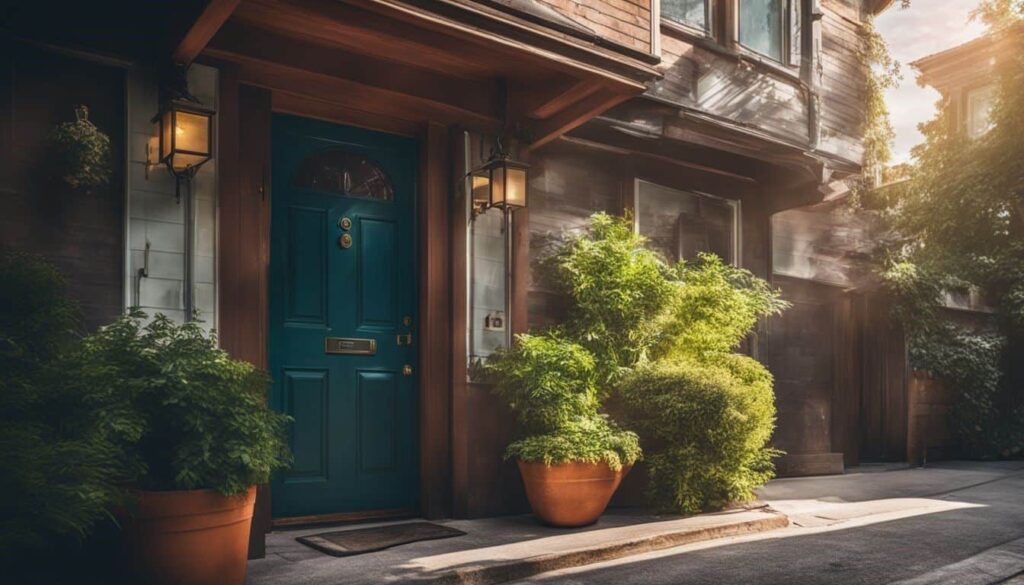
In the realm of home defense, grasping how burglars mark their targets is crucial, pointing us to evaluate the often-overlooked nooks and potential entryways that could leave our sanctuaries exposed to intrusion.
How burglars choose a target
Burglars often look for easy targets where they can strike quickly and without being noticed. They might scout neighborhoods, looking for homes that show signs of poor security—like overgrown bushes or dark areas around the house.
Homes that seem empty, perhaps with no car in the driveway or mail piling up, can attract unwanted attention from these criminals.
Security measures like motion sensor lights, alarm systems, and visible security cameras act as strong deterrents to burglars. A neighborhood watch program also makes a difference; it sends a clear signal that residents are vigilant and coordinated in protecting their community.
With nearly 39 million U.S households utilizing alarm systems as of 2023, it’s evident that taking these steps is considered an essential aspect of modern home safety practices.
Possible points of entry for burglars
Understanding how burglars select their targets is crucial, but knowing where they might attempt to enter is equally important. Burglars seek out the weakest points of entry to gain access to your home stealthily and quickly.
- Front, back, and side doors: These are primary entry points as they can sometimes be left unlocked or poorly secured. Reinforce them with deadbolt locks and consider smart locks for added security.
- Windows: They can be particularly vulnerable, especially when located out of sight. Install window sensors and stops, and reinforce glass with window security film.
- Garage doors: Often overlooked in home security plans, ensure your garage has a strong locking device and think about a smart garage door opener that alerts you when it’s opened.
- Sliding doors: These can often be jimmied open or lifted off their tracks. Invest in a robust bar lock or a door sensor that triggers an alarm if tampered with.
- Basement entrances: Hidden from view, these can provide easy access. Secure them with quality locks and use motion detectors for early warning of intrusions.
- Pet doors: Large enough pet openings can allow burglars to reach through and unlock doors. Make sure pet doors aren’t big enough for human access or have electronic locks controlled by pet collars.
- Mail slots and doggie doors: These could give thieves the chance to reach inside. Ensure mail slots are not wide enough for arms to fit through and doggie doors are securely locked when not in use.
- Skylights or roof entries: Rare but possible points of entry that could be exploited if easily accessible. Keep them locked or install alarms specifically designed for these areas.
- HVAC systems: Some systems provide ducts large enough for burglars to crawl through; secure any external access points to HVAC systems.
Assessing your home’s vulnerabilities
To bolster your home’s defenses, you first need to pinpoint its weak spots. A thorough assessment of your home can reveal potential security risks that may attract burglars.
- Examine all entry points, including doors and windows. Check for solid frames, sturdy locks, and the presence of deadbolts. Ensure that each lock functions correctly and consider adding window stops to limit how wide they can open.
- Walk around the perimeter of your house during the day and at night. Look for areas that are hidden from view or poorly lit, as these could provide cover for someone attempting a break-in. Motion-activated lighting can help illuminate these spaces.
- Don’t ignore the upper levels of your home; burglars might use ladders or nearby trees to gain access through an unlocked second-story window.
- Check your garage security by making sure the door leading into your house has a strong lock. Secure any tools that could be used to break into your home inside a locked cabinet or shed.
- Evaluate technology vulnerabilities by changing default usernames and passwords on your home network. Enable multi-factor authentication where possible to add an extra layer of security against cyber criminals.
- Assess how visible expensive items are from the outside—valuables should be kept away from windows to avoid tempting potential thieves.
- Regularly collect mail and packages promptly to avoid attracting porch pirates looking for unattended deliveries.
Securing the Exterior of Your Home

To robustly shield your home from unwelcome intruders, start by securing the exterior; this involves reinforcing doors and windows, installing motion-sensor outdoor lighting to deter potential burglars, carefully locking down garages, safeguarding sheds and additional structures on the property, and smart strategies to thwart porch pirates eagerly eyeing unattended package deliveries.
Securing doors and windows
Securing doors and windows is a vital step in protecting your home from unwanted intruders. Simple upgrades and good habits can make a big difference in your home’s overall security.
- Install Strong Locks: A sturdy deadbolt on every exterior door provides a solid first line of defense. Choose models that meet or exceed industry standards for quality, such as those certified by the American National Standards Institute (ANSI).
- Use Window Locks: Ensure all windows have working locks and remember to lock the windows when you leave the house or go to bed. For additional security, consider adding aftermarket window locks or key-operated levers.
- Reinforce Entry Points: Install strike plates with longer screws so they anchor into the wall studs, not just the door frame. This makes it tougher for doors to be kicked in.
- Upgrade Sliding Doors: Secure sliding glass doors with bars or foot-operated clamps. These prevent the door from being forced open or lifted off its track.
- Apply Window Film: Consider applying safety window film to glass areas. The film can help hold shattered glass together if someone attempts to break in through a window.
- Check Door Hinges: Make sure exterior door hinges are on the inside rather than outside where an intruder could tamper with them.
- Add Smart Tech Options: Equip your home with smart locks that alert you when someone enters or exits and allows you to control access remotely via smartphones.
- Smart Lighting Influence: Illuminate main entry points with smart lighting which can be programmed or remotely controlled to deter burglars who prefer to work in darkness.
- Get Visual Deterrents: Install visible CCTV systems around doors and windows, as their presence alone can discourage potential burglars from attempting to burglarize your dwelling.
- Secure Pet Entrances: If you have pet doors, install electronic ones that only operate when triggered by a device on your pet’s collar, preventing humans from exploiting this potential entry point.
Lighting up the landscape
After ensuring that doors and windows are well-secured, it’s crucial to turn our attention to the exterior lighting of your home. Adequate lighting serves as a powerful deterrent against potential intruders; here’s how to illuminate your property effectively:
- Install motion-activated lights around the perimeter: Place these near entry points and dark areas where burglars could hide. They activate when movement is detected, surprising trespassers and alerting you to their presence.
- Keep the front door area well-lit: A bright porch light not only welcomes guests but also discourages package theft and other criminal activities.
- Use landscape lighting strategically: Position lights along pathways, near decorative elements, and around the garden to eliminate shadowy spaces where someone could lurk undetected.
- Integrate smart lighting systems: With smart home technology, control outdoor lights remotely using your smartphone or set them on timers to simulate presence even when you’re away.
- Opt for LED bulbs for efficiency: LEDs are brighter and use less energy, saving on electricity costs while providing superior illumination for your home’s exterior.
- Consider solar-powered options: These can be an excellent way to light up areas that are farther away from the house without worrying about wiring or electricity consumption.
- Focus on entry gates and fences: Ensure that all points of access are visible at night by placing lights in these locations; this makes it harder for someone to enter your property unnoticed.
- Pay attention to high traffic areas: Garages, driveways, and back entrances should have adequate lighting to deter criminals looking for a quick break-in opportunity.
- Coordinate with neighbors for community safety: Work together to ensure that shared spaces like alleys or walkways have sufficient lighting, creating a safer environment for everyone in the neighborhood.
- Avoid leaving lights on at all times: Utilize timers or smart systems to alternate which lights are on so it doesn’t appear as though you’ve forgotten them, which could signal an empty house.
Securing the garage
Securing your garage is a crucial step in safeguarding your entire home. Many burglars see it as a prime point of entry, not just for theft but also to access the rest of your house.
- Install a sturdy, quality door lock on every entrance to the garage.
- Use a smart garage opener with remote access.
- Ensure windows are secure and covered.
- Install motion – sensor lights around the exterior of the garage.
- Keep the interior door locked at all times.
- Maintain a clean exterior free from tools or ladders that could assist thieves.
- Secure garages during vacations by disconnecting automatic openers.
- Invest in a good quality security alarm for the garage area.
- Never leave the garage door remote visible in cars parked outside.
Securing sheds and outbuildings
Now that we’ve covered how to keep your garage safe, let’s turn our attention to protecting sheds and outbuildings on your property. These structures often house valuable tools and equipment that can be tempting targets for thieves.
- Install solid locks on all shed and outbuilding doors. Use deadbolts or padlocks with a strong hasp for the best protection against forced entry.
- Consider door sensors that alert you when shed doors are opened. Wireless alarms can easily integrate with most home security systems.
- Reinforce shed windows with window locks or transparent burglary – resistant film to prevent easy access through glass.
- Keep the interior of sheds and outbuildings obscured by using curtains or blinds to avoid showcasing the items inside.
- Securely anchor large equipment, like lawn mowers or snow blowers, to the floor using heavy – duty chains and locks.
- Illuminate the perimeter of sheds and outbuildings with motion – activated lights to deter potential burglars scouting at night.
- Install CCTV security cameras facing your sheds and outbuildings; position them so they cover entry points, but also blend discreetly into their surroundings.
- Maintain the landscaping around these structures by trimming hedges and removing potential hiding spots for intruders planning a burglary.
- Post signage indicating your property is monitored by security systems; this can discourage thieves from attempting a break-in due to increased risk of being caught.
- Regularly check sheds for signs of attempted forced entry, wear on locks, or any suspicious activity around them.
Dealing with porch pirates
After securing sheds and outbuildings to thwart burglars, it’s equally important to safeguard your front porch. Porch pirates casually snatch packages left unattended, a risk that peaks during delivery-heavy periods like Prime Day or the holiday season.
To combat this threat, arrange for deliveries when you’re home or ask neighbors to keep an eye out for incoming parcels. For added protection, consider installing a doorbell camera that alerts you when someone approaches your doorstep.
Secure drop-off points further by using lock boxes where couriers can place packages safely. This simple measure puts a barrier between thieves and your goods. Moreover, leveraging technology such as smart locks lets you grant one-time access codes to deliverers for placing items inside your home directly.
By taking these steps actively, you make it much harder for porch pirates to disrupt the safety of your household treasures without deterring from the aesthetics of your exterior space.
Taking an Active Role in Your Home’s Security
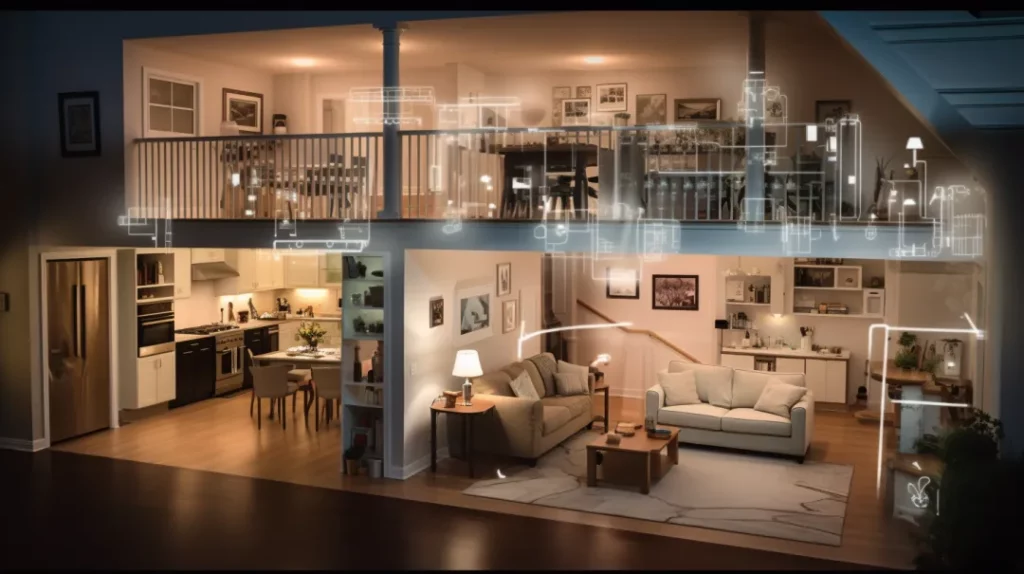
Taking responsibility for your home’s security means adopting daily behaviors that safeguard against intrusion, such as maintaining visibility around entry points and responsibly managing key access, which can significantly reduce the risk of unauthorized entry.
Helpful habits for home security
Creating a secure home environment involves more than just installing gadgets; it’s also about adopting smart habits. Good routines can significantly strengthen your home’s defense against unwelcome intruders.
- Always lock doors and windows before leaving the house or going to bed. This simple act can deter many potential burglars, as unlocked entry points are one of the first things they look for.
- Check and maintain locks regularly to ensure they are functioning properly. A broken lock is like an open invitation for someone trying to burglarize your home.
- Remove spare keys from under doormats or plant pots. Instead, use a lock box or leave a key with a trusted neighbor to prevent easy access for burglars.
- Be discreet on social media about travel plans or new purchases, as sharing too much information can alert robbers that your house is empty or has valuables worth stealing.
- Trim bushes and trees near windows and doors to eliminate hiding spots for thieves looking for opportunities to break in undetected.
- Use timers on lights when you’re away so it appears someone is home, which can discourage potential break-ins.
- Get familiar with your neighbors and consider starting a neighborhood watch program. Close-knit communities are less attractive targets for criminals.
- Regularly review and practice what to do in case of an emergency, such as a burglary attempt, so everyone in the household knows how to respond safely.
Eliminating hiding places
Eliminating hiding places around your home can significantly improve its security and deter burglars. Thieves often seek out hidden spots where they can lurk undetected before breaking and entering. Here’s how to reduce these potential hideouts:
- Trim bushes and trees regularly to keep them from becoming natural cover for intruders. Overgrown vegetation near windows and doors offers a convenient screen for criminals to hide behind while attempting a break-in.
- Install motion sensor lights around your property, especially in areas that are dark or secluded. Bright lighting is a powerful deterrent, as it exposes anyone trying to sneak onto your property.
- Keep the perimeter of your home clear of large items like storage boxes or unused vehicles that could provide a place for burglars to crouch unseen.
- Maintain an organized yard; scattered tools or ladders can not only signal that security is lax but also serve as aids for burglars looking to gain access to higher points of entry.
- Use gravel on pathways or around the house; it’s noisy underfoot and can alert you to someone’s presence outside.
- Arrange outdoor furniture in a way that does not obscure windows or doors from view; ensure that there are no blind spots created by the positioning of chairs and tables.
- Ensure fences and gates are kept in good repair, eliminating gaps or broken panels through which someone could slip into your backyard undetected.
Keeping spare keys in a lock box
Stashing a spare key under your doormat or flowerpot is like inviting burglars for tea. They know all the common hiding spots, which makes it easy for them to slip inside unnoticed.
But when you keep your keys in a lock box, you’re adding an extra layer of defense. These sturdy boxes can be secured with a combination code or key that only trusted individuals have access to.
Lock boxes come in various designs and security levels, offering flexibility based on your needs. You might mount one discreetly by your door or tuck it away out of sight—either way, you’ll rest easier knowing that getting hold of a spare requires more than just flipping over a stone.
Use this method alongside other burglary prevention tactics like strong passwords and alarm systems, because the best defense strategy is always layered and comprehensive.
Password protecting Wi-Fi network
Protecting your Wi-Fi network with a strong password is essential for keeping hackers at bay. Cybercrime is on the rise, and an unsecured network could be an open invitation to criminals looking to steal personal information or infiltrate your home systems.
Use complex passwords that include letters, numbers, and symbols to make it tougher for intruders to gain access. Change these passwords regularly, and never leave them at default settings which can easily be guessed or found online.
Securing your network also means updating firmware frequently. Manufacturers often release updates that patch security vulnerabilities. Staying current helps prevent unauthorized access from those who might exploit outdated software to hack into your system.
Next up, explore how adding additional security measures like cameras can enhance overall protection for your home.
Adding Additional Security Measures
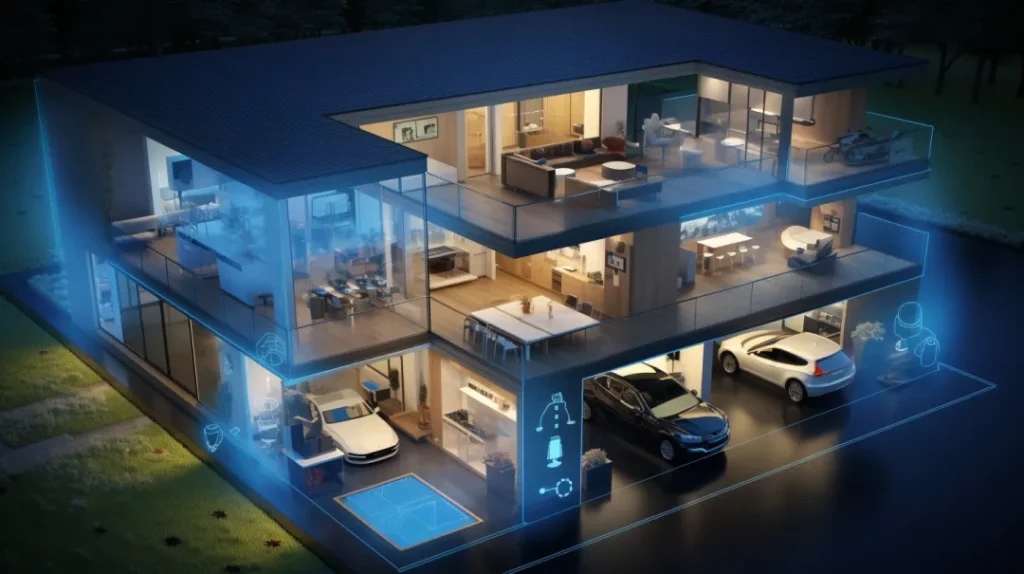
Incorporating additional layers of protection, such as cutting-edge security cameras and smart home automation, markedly enhances your defense against potential intruders. Investing in a robust safe provides a secure haven for valuables, while modern home security systems offer comprehensive solutions that integrate seamlessly into daily life for peace of mind.
Installing security cameras
Installing security cameras is a smart move to enhance your home’s defense against burglaries and other crimes. Modern technology offers homeowners a variety of options to monitor their property effectively.
- Choose the right type of camera for different areas around your home. Indoor cameras can keep an eye on the inside, while weatherproof outdoor cameras are essential for covering the perimeter.
- Place cameras strategically to cover all potential entry points, such as front and back doors, first – floor windows, and garage doors.
- Opt for cameras with motion detection capabilities to save storage space and make it easier to review footage when needed.
- Consider night vision features for clear recording after dark, ensuring that your security doesn’t lapse with the setting sun.
- Ensure your Wi – Fi network is secure to prevent cyber criminals from hacking into your camera system. Use strong passwords and update them regularly.
- Look for cameras that offer live streaming, so you can monitor your home in real-time from your smartphone or another device no matter where you are.
- Check if the system integrates with other smart home devices, like Alexa Guard or smart locks, for a comprehensive approach to home security.
- Be aware of local privacy laws regarding recording video and audio as they vary by state; ensure compliance to avoid legal issues.
Using home automation
Home automation is a game-changer for residential security, transforming ordinary homes into smart fortresses. It integrates technology seamlessly to manage and protect your home more efficiently.
- Control access remotely: Smart locks and garage door openers allow you to unlock or secure your home from anywhere using your smartphone. This means no more worrying if you forgot to lock the door; simply check and adjust the setting through an app.
- Monitor real-time with cameras: Install security cameras that connect to Wi-Fi, enabling live streaming of footage directly to your mobile device. You can watch over your home 24/7, receiving alerts if any unusual activity is detected.
- Automate lighting for safety: Program outdoor and indoor lights to turn on and off at specific times or when motion is sensed. Brightness discourages burglars who prefer targeting homes that appear unoccupied.
- Protect against cyber threats: Secure your Wi-Fi network with a strong password, guarding against hackers and cyber crime. This prevents outsiders from accessing your personal information or interfering with connected security devices.
- Manage heating and air conditioning: Smart thermostats keep you comfortable while saving energy when no one’s home. Adjust the temperature remotely to prevent issues like frozen pipes which can lead to water damage.
- Integrate alarms wisely: Connect smoke detectors and carbon monoxide sensors to your system for immediate alerts at the first sign of danger. These instant notifications could save precious minutes in an emergency.
Investing in a safe
Investing in a safe can shield your valuables from burglars and give you peace of mind. Whether it’s jewelry, cash, or important documents, a sturdy safe acts as the final barrier against theft.
Make sure to choose one that’s robust and tamper-proof; consider safes that are fire-resistant too, which add an extra layer of protection. Some modern safes even come with biometric locks, ensuring only authorized users have access.
Placing the safe in an inconspicuous location makes it less likely a burglar will find it during a robbery attempt. Bolt it securely to the floor or wall so it cannot be easily removed.
If you own firearms, investing in a gun safe is particularly crucial for both safety and compliance with home insurance policies. Now that your most precious items are secured inside your impenetrable safe, let’s explore how considering home security systems adds another dimension to protecting your household.
Considering home security systems
While a safe can protect your valuables from burglars, exploring home security systems adds another layer of defense to your household. Modern security devices offer protection beyond just deterring intruders; they help ensure that even when you’re away, your home is monitored around the clock.
With 39 million U.S. households equipped with alarm systems and about 85% of police officers endorsing them as effective deterrents, it’s clear how much value people place on securing their living spaces.
Home security systems range from basic alarms that signal unauthorized entry to advanced setups that include cameras, motion detectors, and smart technology integration. These systems can send instant alerts to homeowners’ phones and sometimes even directly contact law enforcement.
This immediate response capacity makes them an invaluable tool in protecting against those who might attempt to burgle or hack into your home. Keep in mind that investing in these technologies not only wards off would-be criminals but often leads to discounts on homeowner’s insurance – a win-win by bolstering both safety and savings.
Preventing House Fires

Protecting your home from the threat of burglars is crucial, but don’t overlook the importance of fire prevention. House fires can be just as devastating and often strike without warning. Here are some key strategies to help prevent them:
- Install smoke detectors on each level of your home, especially near bedrooms; test them monthly and replace batteries at least once a year.
- Keep a fire extinguisher accessible in high-risk areas such as the kitchen, garage, and near any fireplaces or wood stoves.
- Regularly inspect electrical cords for damage and replace if frayed or worn to avoid potential sparks that could ignite a fire.
- Limit the use of extension cords, as they can overheat; consider having additional outlets installed by a professional if necessary.
- Ensure appliances are turned off when not in use and keep them away from flammable materials like curtains or paper goods.
- Clean lint filters in your dryer after every cycle and check behind the machine periodically for buildup that might catch fire.
- Maintain a clear area around space heaters with at least three feet between the heater and anything that can burn.
- Have heating systems checked annually by a professional to prevent malfunctioning components from igniting.
- Practice safe cooking habits: never leave pots unattended on the stove, keep combustible objects away from burners, and double-check that everything is off after use.
- Educate all household members about emergency plans including escape routes and meeting points outside of your house in case of fire.
Home Security Tips and Facts
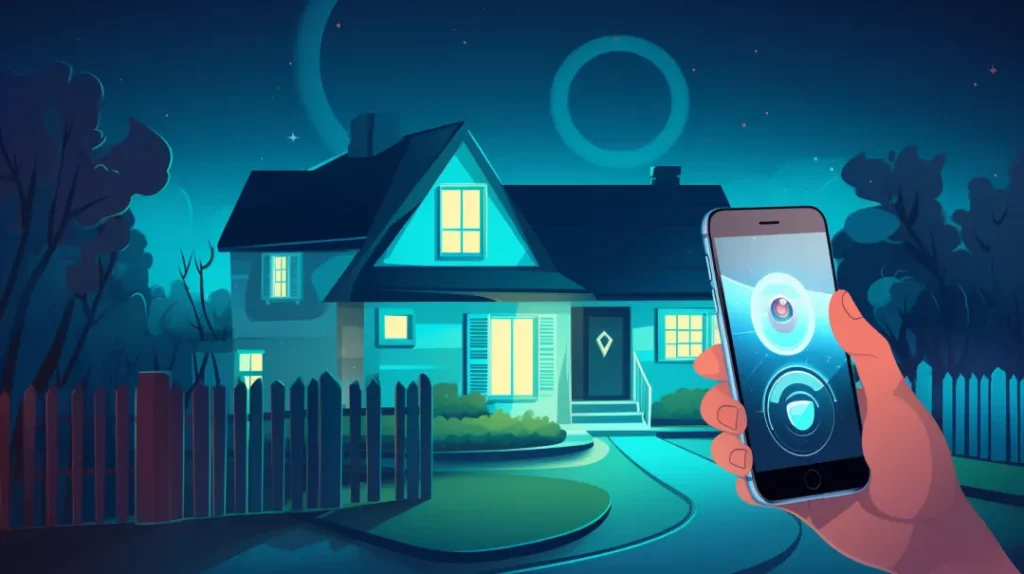
Home Security Tips and Facts: Dive into a treasure trove of strategies and lesser-known facts that bolster your home’s defenses, including insights on how to enhance door and window security along with both indoor and outdoor protection tactics.
Door and window security
Door and window security are essential components in safeguarding your home from potential intruders. These points of entry are often targeted first by burglars, so it’s critical to reinforce them.
- Install sturdy, deadbolt locks on all exterior doors. Deadbolts provide an extra layer of protection that ordinary locks can’t match.
- Ensure windows have secure locks and consider installing window sensors that alert you if they’re opened unexpectedly.
- Use reinforced glass or add window security film to make your windows harder to break. Burglars typically look for the path of least resistance.
- Add bars or metal grates outside basement or ground-level windows if privacy allows. This can be a strong visual deterrent for would-be intruders.
- Place visible signs or stickers that advertise your security measures, including alarm system decals, which can discourage burglars from attempting a break-in.
- Don’t forget about sliding doors; use a security bar in the track to prevent the door from being forced open or lifted off its track.
- Keep doors and windows locked at all times when not in use, even on higher floors—burglars might use ladders to access unlocked second-story entries.
- Regularly inspect door frames and window casings for signs of wear or damage that could make them easier targets for being forced open. Repair any weaknesses promptly.
- Integrate smart locks with your home automation system for remote monitoring and control over who can enter your home and when.
- Be mindful of skylights and other less obvious entry points, securing them properly to avoid offering criminals access points they could exploit.
Inside and outside security
Securing your home means safeguarding both the interior and exterior spaces from unwanted intruders. Consider these strategies to reinforce the safety of your living environment.
- Install quality locks on all doors, ensuring deadbolts are in place for an added layer of protection.
- Protect windows with shatter – resistant film and window bars if necessary to prevent easy access through glass areas.
- Set up a security camera system that monitors the front door, back door, and any first-floor windows, frequently targeted by burglars.
- Illuminate outdoor spaces with motion – sensor lights to deter prowlers and bring attention to any suspicious activity around your property.
- Trim bushes and trees near the house to eliminate potential hiding spots for thieves who might lurk in the shadows.
- Use curtains or blinds on inside windows so valuable items aren’t easily visible from the outside, reducing temptation for passersby.
- Establish a routine of checking that all doors and windows are locked before leaving the house or going to bed.
- Consider adopting a dog; their barking can scare off potential intruders and alert you to unexpected visitors.
- Connect your security systems to a monitored alarm service that can alert authorities in case of break-ins, which police believe is an effective deterrent.
- Regularly update passwords on your Wi – Fi network, which helps prevent digital intrusions like hacking or malware infections.
- Encourage neighbors to keep an eye out for each other’s homes, creating a close – knit community watch that discourages burglaries.
Company Research
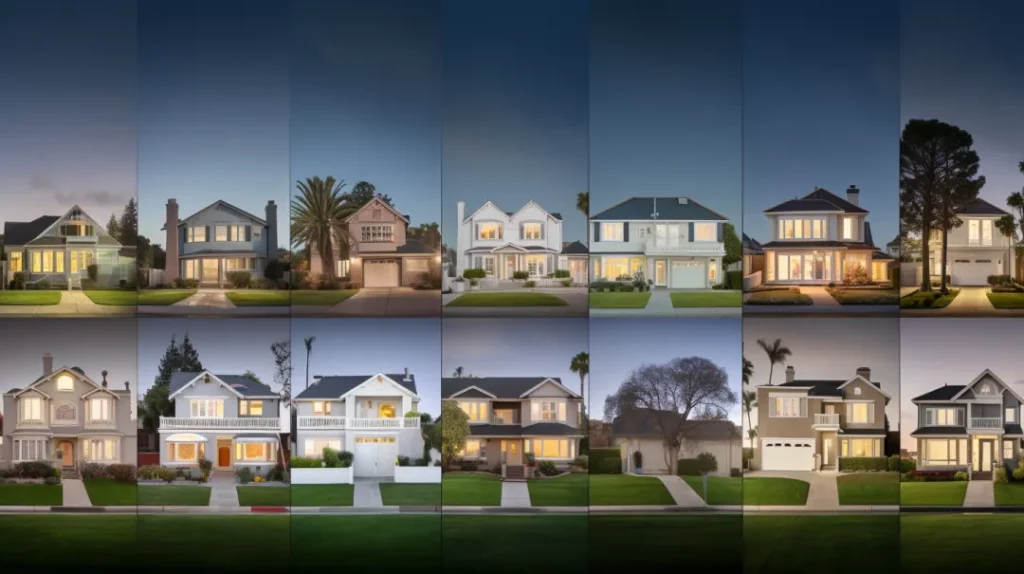
Thoroughly compare top-tier home security systems to empower homeowners with the knowledge they need to choose a solution that aligns with their specific safety requirements and lifestyle preferences.
Comparing the best home security systems
When seeking the perfect home security system, modern households benefit from comparing features and services to find the ideal fit for their specific needs. Currently, with a wide array of options on the market, it’s essential to evaluate key factors such as monitoring services, installation methods, customer support, and smart home integration. Below is a comparative analysis of top home security systems that have been rated highly by users and experts alike.
| Company | Monitoring Options | Installation | Smart Home Compatibility | Price Range | Unique Feature |
| SimpliSafe | Professional, Self | DIY | Limited | $229-$489 | 60-Day Trial Period |
| Vivint | Professional | Professional | Extensive | $599-$1,799 | Integrated with Solar Panel Option |
| ADT | Professional | Professional | Good | $599-$899 | Long-Standing Industry Reputation |
| Frontpoint | Professional | DIY | Good | $392.40-$479.90 | Crash and Smash Protection |
| Ring | Self, Professional | DIY | Extensive | $199-$329 | Neighborhood Watch Feature |
This table serves as a streamlined guide for homeowners to discern which system aligns with their safety requirements and lifestyle preferences. With the prevalence of home security implementations, as indicated by the 39 million U.S. households utilizing alarm systems, the value of informed decision-making cannot be overstated. It is worth noting that young adults are particularly proactive in ensuring their domestic peace of mind, as evidenced by their likelihood to adopt such technologies. The right home security system not only helps to deter potential intruders but also provides a sense of security that is invaluable to modern living.
Home Security Resources
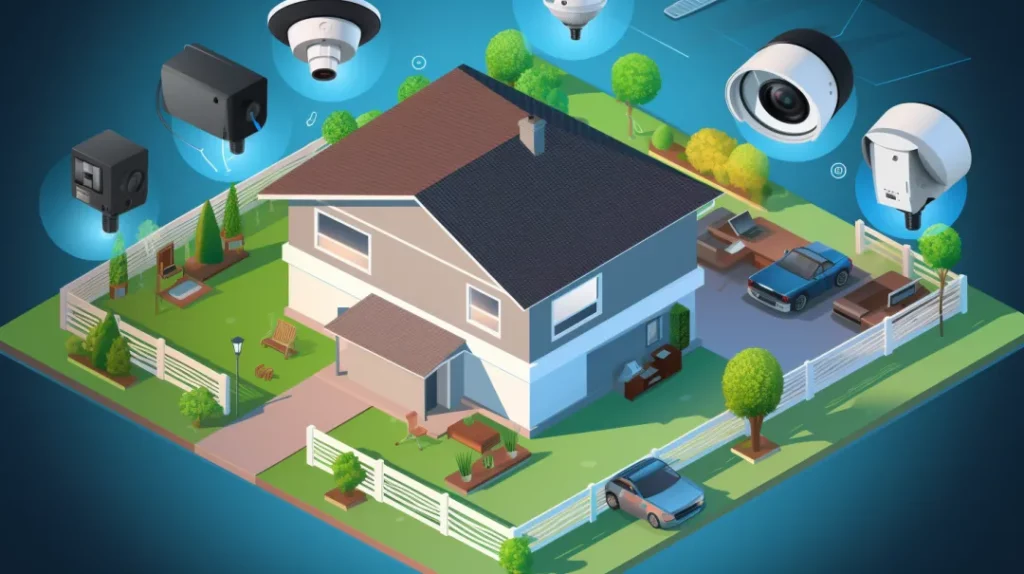
Explore our curated selection of articles and studies to sharpen your understanding of home security tactics; a treasure trove awaits for those eager to delve deeper into safeguarding their sanctuary.
Additional articles and studies
Diving deeper into home security leads to a wealth of articles and studies that shed light on the latest trends and technologies in safeguarding your living space. Researchers continuously analyze how burglars think and the weak spots they seek out in potential targets.
These findings help shape more robust security systems, often revealing surprising methods for keeping homes safe from intruders. For instance, recent publications suggest changing exterior lighting setups can significantly reduce break-in risks.
Innovations in home automation are frequently highlighted in scholarly articles, showcasing their role in deterring crime before it happens. Studies have demonstrated that integrating smart devices with traditional security measures enhances overall protection, sometimes even preventing hackers from gaining unauthorized access to personal data or Wi-Fi networks.
Homeowners looking for advanced strategies beyond basic locks and alarms can find peer-reviewed research detailing the effectiveness of these modern solutions against thefts and false alarms generated by older systems.
Conclusion

Protect your home with the right mix of vigilance and technology. Don’t underestimate the power of good habits and smart devices to keep burglars at bay. Wondering how secure your residence really is? Start by checking doors, windows, and Wi-Fi passwords.
Remember that simple solutions like proper exterior lighting can make a big difference. Explore more strategies to enhance safety without breaking the bank. Take action today for peace of mind tomorrow – your home’s security depends on it!
For professional installation of top-rated security cameras and alarm systems, contact the experts at Jefferson Security Cameras at (267) 662-1423 or visit https://jeffersonsecuritycameras.com/contact/ to schedule your free quote. Our seasoned team stays on top of the latest innovations so you can fortify your home with confidence.
FAQs
How can I make my doors and windows more secure against intruders?
Reinforce doors and windows by installing sturdy deadbolt locks, using high quality strike plates anchored into wall studs, adding secondary locks, and applying window stops. Consider smart home tech like sensors to alert you if entry points are breached.
What lighting tactics effectively deter burglars?
Strategically place motion-activated or smart lights around the house perimeter and key areas like doors and pathways. Bright, inconsistent lighting gives the impression that the house is occupied and monitored.
How do I secure my garage against break-ins?
Use a sturdy lock on the exterior garage door, lock the interior door leading inside, install motion lights outside, cover windows securely, and disable automatic openers when away. Store ladders/tools securely.
How can I prevent package theft from my porch?
Choose secure delivery locations like lock boxes, require signatures, use smart locks to allow delivery inside the home, install video doorbells to see visitors, and enlist neighbors to retrieve packages.
What high-tech security measures can boost my home’s protection?
Consider monitored alarm systems to alert authorities of intrusions, Wi-Fi cameras to live-stream video of activity inside and around the home, and smart home automation to control lighting, locks, temperature and more remotely.
